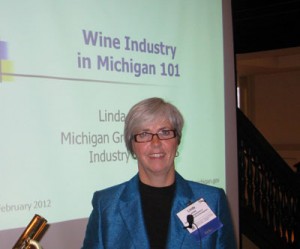Michigan Wine Industry on the Threshold of “Legitimacy”

R. Brent Ross, Assistant Professor, Michigan State University Dept. of Agricultural, Food and Resource Economics
The primary goal for the Michigan wine industry is “legitimacy,” according to both Linda Jones, Executive Director of the Michigan Grape and Wine Industry Council (MGWIC) and Dr. Brent Ross, Assistant Professor at Michigan State University. As the top Midwestern state for both grape and wine production, Michigan’s wine industry has progressed to the point where the next stage of growth will involve national and global recognition, according to both Jones and Ross who spoke on the opening day of Michigan Grape and Wine Conference in Grand Rapids on February 22nd.
Whether Michigan becomes established as part of the global wine industry boils down to a simple question according to Ross: “Do consumers view wines from emerging regions like Michigan and Missouri on par with wine regions like California and Spain?”
Jones, who joined MGWIC in ’98 as Executive Director, told the audience that she currently views Michigan in a third tier of wine producing states that includes Texas, Missouri, Virginia and North Carolina. (She identified New York, Oregon, and Washington in the second tier.) Third tier wine states, like Michigan, win national awards regularly and have gained a respect for quality with consumers and the media. However, wines from Michigan and other emerging regions are generally available only in a winery’s home state or surrounding states.
How do Michigan and other Midwestern states move up the ladder? To answer that question, Ross and MSU are in the midst of a series of studies that look at “undiscovered” wine regions like Missouri, Michigan, and Pennsylvania. One area of emphasis in Ross’s study of emerging wine regions is how much local fruit is being used to produce a state’s wines.
“Michigan uses a lot of bulk wine. In our study, 60% of Michigan wineries use bulk wine,” Ross said. Jones agrees that part of Michigan’s quest to move into the next tier of wine producing states is to use local grapes. “Our reputation will be built on wine that’s made with grapes that are grown in the state,” she said.
Grape production is an industry where Michigan has a built-in advantage over many other states. According to Jones, the long-established juice grape industry in Michigan has $503 million in annual sales compared with $287 million in sales for the wine industry. However, she also explained that the economic impact of the wine industry is greater because of tourism.
“We’re fortunate to have a large grape industry in Michigan that creates a lot of synergy,” Jones said. “Pest management, vine vigor, and soil nutrition all have similarities between juice and wine grapes so we can partner with our friends at Welch’s to get research done.”
Jones anticipates that a 2011 USDA survey of Michigan wine production, due to be released this year, will report a total acreage of between 4,000 and 5,000 acres of wine grapes. When the USDA last did a wine grape survey in ’06, there were only 2,000 acres of wine grapes in Michigan, although Jones thinks the ’06 survey might have under reported acreage.
Wine industry growth figures like these should be compelling to banks reviewing winery loan applications and business plans. But both Jones and Ross think that one challenge to the legitimacy of Michigan wine is attracting expansion capital. “Because most wineries in emerging wine areas are less than 10 years old, bankers and investors don’t have much of a track record on which to base funding decisions. In addition, most Midwestern banks don’t understand the long period of time it takes for regional wineries to become profitable,” Ross said.
Ross’s survey, which was conducted in 2011, showed most Michigan winery owners, and most winery owners in other emerging markets, are not in it simply for money. According to Ross, the main reason to start a winery in Michigan is a “passion for food and wine.”
Such enthusiasm bodes well for Michigan wine as does Ross’s finding that Michigan winery owners spend over three-quarters of their time working in the winery. “For the most part Michigan winery owners are committed to their wineries as opposed to being absentee owners,” Ross said. “Our study also found that they also have more than 50% of their net worth invested in their winery.”
What this all adds up to, according to Jones, is a wine industry that is becoming a major part of the state economy. “For the Michigan Grape and Wine Industry Council, we’re about reinventing Michigan and creating a more vibrant economy. Growing the agro foods sector increases jobs and increases exports,” she said.
As the importance of the Michigan wine industry grows, MGWIC will become involved in conversations about issues like rural broadband access and better roads, Jones said. MGWIC will also continue to work closely with the “Pure Michigan” tourism campaign. To support tourism, Jones produces a full color wine magazine and tourist guide that numbered 62 pages last year. In early April, she will begin distribution of 200,000 copies of the 2012 edition of “Michigan Wine Country.” Copies can be ordered at http://www.michiganwines.com/page.php?page_id=474
With a mild winter and uncharacteristically dry roads, many Michigan wineries at the Conference reported stronger than average sales this winter. With momentum going into 2012, this could be the year that Michigan wines break out on the national scene.



